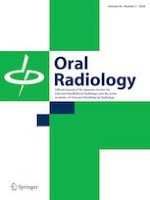Published in:

18-12-2023 | Chondrosarcoma | Original Article
CT and MR imaging findings of head and neck chondrosarcoma
Authors:
Yoon Joo Choi, Sang-Sun Han, Chena Lee, Kug Jin Jeon
Published in:
Oral Radiology
|
Issue 2/2024
Login to get access
Abstract
Objectives
This study investigated the imaging features of head and neck chondrosarcoma (HNCS) according to its origin and pathologic subtype.
Methods
Patients who were pathologically diagnosed with HNCS between January 2000 and April 2022 were retrospectively reviewed. Lesions were classified based on their origin and pathologic subtype. The size and margin were evaluated on the image. Internal calcification and the effects on adjacent bone were assessed using computed tomography (CT) images, while signal intensity and contrast enhancement patterns were analyzed using magnetic resonance (MR) imaging.
Results
Thirteen HNCSs were included in this study: 8 bone tumors (61.5%) and 5 soft tissue tumors (38.5%). The bone tumors were pathologically diagnosed as conventional (n = 5) and mesenchymal type (n = 3). Soft tissue tumors were defined as myxoid type. The main symptoms were swelling (90.9%) and pain (72.7%). The lesions measured 4.5 cm on average. The margins showed benign and well-defined except for the mesenchymal type. On CT, most bone tumors (75%) showed internal calcification with remodeling or destruction of the adjacent bone. No soft tissue tumors, except one case, showed internal calcification or destruction of the adjacent bone. MR imaging features were non-specific (T2 high signal intensity and contrast enhancement).
Conclusions
HCNS showed various imaging findings according to their origin and pathologic subtype. HNCS should be differentiated if a bone tumor shows internal calcification and affects the adjacent bone. When diagnosing slow-growing soft tissue tumors, even if low possibility, HNCS should be considered.